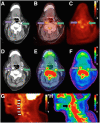Radiotracers to Address Unmet Clinical Needs in Cardiovascular Imaging, Part 2: Inflammation, Fibrosis, Thrombosis, Calcification, and Amyloidosis Imaging
- PMID: 35772956
- PMCID: PMC9258561
- DOI: 10.2967/jnumed.121.263507
Radiotracers to Address Unmet Clinical Needs in Cardiovascular Imaging, Part 2: Inflammation, Fibrosis, Thrombosis, Calcification, and Amyloidosis Imaging
Abstract
Cardiovascular imaging is evolving in response to systemwide trends toward molecular characterization and personalized therapies. The development of new radiotracers for PET and SPECT imaging is central to addressing the numerous unmet diagnostic needs that relate to these changes. In this 2-part review, we discuss select radiotracers that may help address key unmet clinical diagnostic needs in cardiovascular medicine. Part 1 examined key technical considerations pertaining to cardiovascular radiotracer development and reviewed emerging radiotracers for perfusion and neuronal imaging. Part 2 covers radiotracers for imaging cardiovascular inflammation, thrombosis, fibrosis, calcification, and amyloidosis. These radiotracers have the potential to address several unmet needs related to the risk stratification of atheroma, detection of thrombi, and the diagnosis, characterization, and risk stratification of cardiomyopathies. In the first section, we discuss radiotracers targeting various aspects of inflammatory responses in pathologies such as myocardial infarction, myocarditis, sarcoidosis, atherosclerosis, and vasculitis. In a subsequent section, we discuss radiotracers for the detection of systemic and device-related thrombi, such as those targeting fibrin (e.g., 64Cu-labeled fibrin-binding probe 8). We also cover emerging radiotracers for the imaging of cardiovascular fibrosis, such as those targeting fibroblast activation protein (e.g., 68Ga-fibroblast activation protein inhibitor). Lastly, we briefly review radiotracers for imaging of cardiovascular calcification (18F-NaF) and amyloidosis (e.g., 99mTc-pyrophosphate and 18F-florbetapir).
Keywords: fibrosis; inflammation; molecular imaging; radiotracers; thrombosis.
© 2022 by the Society of Nuclear Medicine and Molecular Imaging.
Figures





Similar articles
-
Radiotracers to Address Unmet Clinical Needs in Cardiovascular Imaging, Part 1: Technical Considerations and Perfusion and Neuronal Imaging.J Nucl Med. 2022 May;63(5):649-658. doi: 10.2967/jnumed.121.263506. J Nucl Med. 2022. PMID: 35487563 Free PMC article. Review.
-
Molecular imaging of amyloidosis: will the heart be the next target after the brain?Curr Cardiol Rep. 2012 Apr;14(2):226-33. doi: 10.1007/s11886-011-0239-5. Curr Cardiol Rep. 2012. PMID: 22193845 Review.
-
Multimodal Molecular Imaging Reveals High Target Uptake and Specificity of 111In- and 68Ga-Labeled Fibrin-Binding Probes for Thrombus Detection in Rats.J Nucl Med. 2015 Oct;56(10):1587-92. doi: 10.2967/jnumed.115.160754. Epub 2015 Aug 6. J Nucl Med. 2015. PMID: 26251420 Free PMC article.
-
Advances in PET-Based Cardiac Amyloid Radiotracers.Curr Cardiol Rep. 2020 May 19;22(6):40. doi: 10.1007/s11886-020-01284-3. Curr Cardiol Rep. 2020. PMID: 32430600 Review.
-
Advanced Nuclear Medicine and Molecular Imaging in the Diagnosis of Cardiomyopathy.AJR Am J Roentgenol. 2020 Nov;215(5):1208-1217. doi: 10.2214/AJR.20.22790. Epub 2020 Sep 9. AJR Am J Roentgenol. 2020. PMID: 32901569 Review.
Cited by
-
Beyond perfusion imaging.J Nucl Cardiol. 2022 Aug;29(4):1485-1486. doi: 10.1007/s12350-022-03050-0. Epub 2022 Jul 5. J Nucl Cardiol. 2022. PMID: 35790690 No abstract available.
-
Ferumoxytol-enhanced MRI assessment of venous Thrombus resolution and macrophage content in a murine deep vein thrombosis model.Thromb Res. 2024 Aug;240:109063. doi: 10.1016/j.thromres.2024.109063. Epub 2024 Jun 13. Thromb Res. 2024. PMID: 38878741 Free PMC article.
-
Exploration of 68Ga-DOTA-MAL as a Versatile Vehicle for Facile Labeling of a Variety of Thiol-Containing Bioactive Molecules.ACS Omega. 2023 Jan 27;8(5):4747-4755. doi: 10.1021/acsomega.2c06720. eCollection 2023 Feb 7. ACS Omega. 2023. PMID: 36777559 Free PMC article.
-
Uncovering atherosclerotic cardiovascular disease by PET imaging.Nat Rev Cardiol. 2024 Sep;21(9):632-651. doi: 10.1038/s41569-024-01009-x. Epub 2024 Apr 4. Nat Rev Cardiol. 2024. PMID: 38575752 Free PMC article. Review.
-
Regulatory Agencies and PET/CT Imaging in the Clinic.Curr Cardiol Rep. 2022 Oct;24(10):1361-1371. doi: 10.1007/s11886-022-01749-7. Epub 2022 Aug 1. Curr Cardiol Rep. 2022. PMID: 35913674 Free PMC article. Review.
References
-
- Murphy SP, Kakkar R, McCarthy CP, Januzzi JL, Jr. Inflammation in heart failure: JACC state-of-the-art review. J Am Coll Cardiol. 2020;75:1324–1340. - PubMed
-
- Weirather J, Hofmann UD, Beyersdorf N, et al. . Foxp3+ CD4+ T cells improve healing after myocardial infarction by modulating monocyte/macrophage differentiation. Circ Res. 2014;115:55–67. - PubMed
MeSH terms
Substances
Grants and funding
LinkOut - more resources
Full Text Sources
Medical
